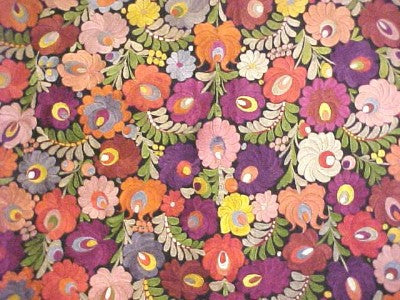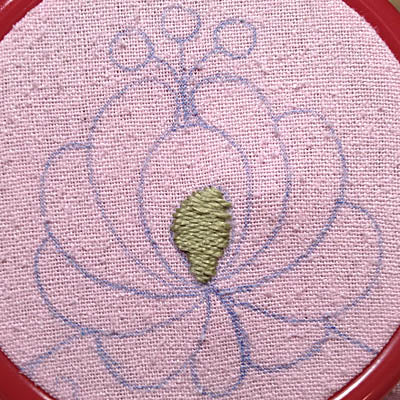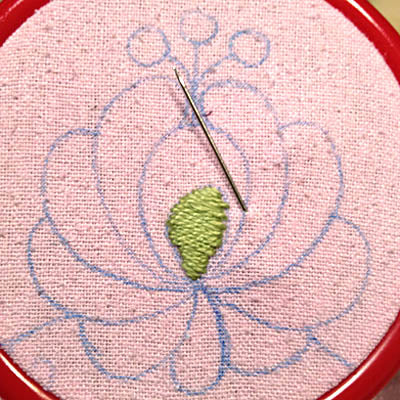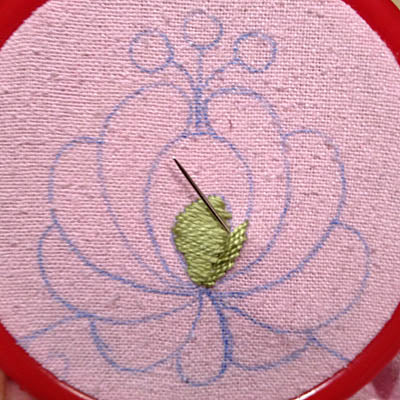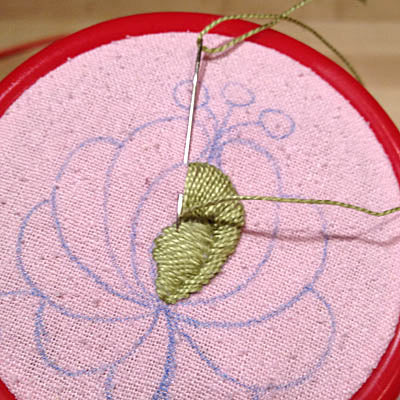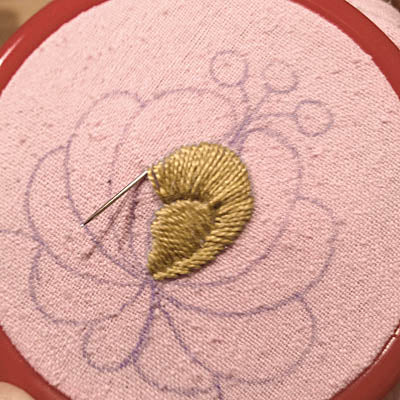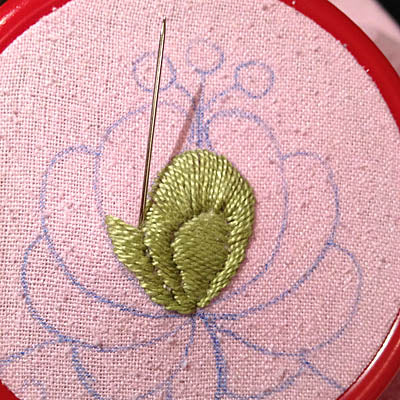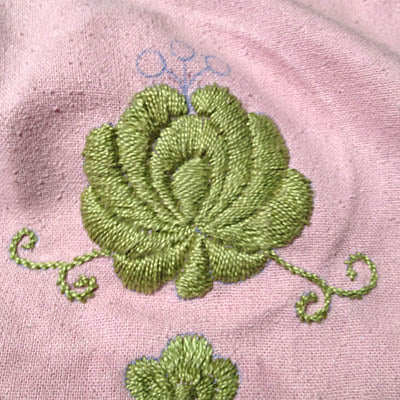Hungarian Sampler Part Nine (the last): Matyó rose from Northern Hungary
This is the ninth and last part of the Hungarian Sampler series, in which we embroider various Hungarian motifs on a tank top made using Colette Patterns' free Sorbetto Top pattern. Can you believe it? It's almost done! It just occurred to me that having nine parts is rather auspicious - nine is, in most folklore traditions so in Hungarian as well, an important number. I should claim I carefully planned it this way... but that wouldn't be entirely true. The last motif in the sampler is one of the most well-known shapes in Hungarian embroidery: it is a rose, a cabbage rose to be precise, made up of a series of petals that curl around a seed at its center. It comes from a region that raised wildly colorful floral embroidery to a true art form that I find stunningly beautiful every time I see it:
Or look at this:
I mean, isn't it gorgeous?The Matyó people's embroidery wasn't always this colorful. Until the early 19th century mostly all-white thread was used, then stitchers began to use blue and red, then in the late 19th century, when colorfast cotton thread became widely available, a veritable color explosion occurred. First yellow, green, and purple began to appear, then after the 1890s, as threads in more and more colors came on the market, light purple, pink, and black are introduced. It is also from about this period onward that the embroidery covers all of the surface area of the embroidered cloth; earlier examples were more loosely stitched. The stitching style itself is interesting: these days it's primarily stem stitch and satin stitch, with the stitches sometimes laid in the way Kalocsa embroiderers lay them, which is completely parallel within each filled-in area at all times. There were many more stitches used in the past, even one called the Matyó figure-eight stitch - a kind of couched satin stitch used to fill areas for which the regular satin stitch would be too unstable: the stitch would be too long to stay put. But Matyó embroidery's roots go back to a slightly different kind of satin stitch that was traditionally used to embellish leather overcoats, mostly men's mantles. The stitches are often not parallel, they "curve" a bit to make the rounded shapes for which this style is known come out smooth and even. Take a look, for example, at this close-up of a man's overcoat from the collection of the Met:
See how the direction of the stitches changes to create a curved effect? And how fully the embroidery covers the available surface? Funny thing is, this was a man's craft: embroidering on leather jackets and mantles. However, one of the most famous modernizers of Matyó embroidery in the early 1900s, Kis Jankó Bori (or Molnár Borbála by her full name) learned to embroider from her grandfather, a well-known leathercrafter. (Funny little tidbit: her grandfather's full name was Nagy János or Big John - 'nagy' means, very simply, 'big' in Hungarian, and János is John, also, one's family name always comes first; and... Kis Jankó was this leathercrafters rather tongue-in-cheek nickname in the village, with the meaning 'Little Johnny... ('kis' means 'little'). He was so well known, however, that even his granddaughter is, to this day, mentioned only with his nickname as her family name. In any case, you can see in this closeup of a fancy Matyó apron (also from the Met) how similar the stitching technique is to that on the mantle above:
You have to give a little thought to where you place them if you're used to satin stitching with parallel stitches but it's really not as hard as you think. So, without further ado - let's get stitching on our own rose, and learn how to make this rose:

Now, I should tell you that this is the one time I'd very much recommend reading through the instructions before starting to stitch, if you've never done much satin stitching before. It will seem like rather a lot at first but the funny thing is, once you get the hang of it, it's not hard. We'll start with the center of the flower, the seed. We'll fill in the individual shapes starting in the middle, placing the stitch on a slanted line:
And working towards the narrow tip of the shape:
And keep going, with shorter & shorter stitches:
Until the tip is filled in. Then, on the backside of your embroidery, weave your thread back under bottom of your stitching, and bring your needle up at the edge of the top stitch, on the OTHER side compared with where you started embroidering previously:
And start filling in the top portion of this shape:
Until you're done:
Basically, you switch the stitches' direction at about the middle of the shape. Here's a little sketch to illustrate - the arrows begin where the needle comes up from under the fabric, and the tips point to where needle goes back down:
Stitching with the sewing method (like I have been - starting and finishing each stitch with one motion, basically, and keeping your hand on one side of the fabric at all times), this means that the arrowheads are pointed to where the eye of the needle should be, pulling the thread down into the fabric. The "front" or leading tip of the stitch on the right side of the embroidery. If that sounds confusing, try working with the stabbing method instead of my sewing method for a while - so move your hand to the other side of the fabric after you stitch down, then stitch up in a separate motion, then move your hand to the right side of the fabric again and stitch down in a separate motion, and so on. Moving on to the next shape - bring your needle up on the OUTER edge of one of the "legs" of the shape that surrounds the seed you just finished:
Stitch down lower on the "leg" of this shape, slanting your stitch down and a bit towards the point where all the shapes meet, at the bottom tip of the seed, like this:
Keep going like this for a couple of stitches:
At this point, depending on how tightly you stitch, you might find yourself curving your stitches slightly under as you fill in the narrow "leg" of this shape:
Until you've filled in this part of the shape:
Then, bring your needle up at the top of the filled-in bit, on the INNER outline of this shape:
You see how we've switched the direction of our stitches, just like when filling in the seed shape? Now, begin filling in around the widening part of the shape surrounding the seed:
Slightly fanning out the stitches along the outer edge of the shape:
See how the needle's orientation changes:
 Until it's right on the center line of the motif, with the stitches at the top of this shape going pretty much straight up and down:
Until it's right on the center line of the motif, with the stitches at the top of this shape going pretty much straight up and down: 
Kind of like the hand of a clock (except, I now notice, this clock is actually going counter-clockwise... ; ) If you find that as you're fanning out your stitches, there is an overly large gap somewhere, like this one:
You can fix it by going back and putting in a stitch that covers the gap:
See how nicely that took care of the gap:
Or, you can alternate partial-length stitches with full-length stitches to achieve a more even fanning effect (like in the Variations post) - first a shorter stitch:
Then a full-length stitch that overlaps the inner tip of the shorter stitch:
When you get close to a point that's about the height where on the other side of this shape we changed stitch directions, do the same thing here - though this time it will mean you'll just "pinch" a couple threads of your fabric to let your needle come up right next to where you previously stitched down:
Then keep going, as if you were stitching the mirror image of what you did on the other side of this shape:
Until you fill it in all the way to the point where the tips of all the petals meet:
There, you've just completed the most challenging portion of this motif! It only gets easier from here on out. So, bring your needle up again at the outer edge of one of the petals next out from the shape you just finished filling in:
And fill in the tip of this petal, in the same way you filled in each leg of the previous shape, with slanting stitches:
The stitches might even curve slightly under towards the very end of the shape:
Then on the back of your stitching, slip your needle under the backs of your stitches and bring it up on the INNER edge of the shape, switching your stitch
direction:
At this point, I often turn my embroidery around too, so I will show you what that looks like - continuing to fill in the rest of this shape, just slanting my stitches for a few:
Then fanning them out slightly at the outer edge of the shape, just like in the shape we filled out previously (note how the needle's orientation changes):
Keep going like this:
If you need to go back and put in a correctional stitch to make fanning out along the outer outline, do so:
Until, towards the end of this petal, your stitches & needle are parallel to the center line of the motif:
And your stitches become real short - until the petal's done. Then do the same thing on the petal opposite - I find I get much better results if I fill in shapes in a way that matches the symmetry of the motif itself - so I'd fill in the matching petal on the other side of the motif before moving on to an adjacent petal:
First the narrow tip:
Then switch your stitch direction, bringing your needle back up to the inner outline of where you began filling this petal (I usually turn my embroidery back around at this point):
Filling in the top of this petal, then moving on to an adjacent petal, and filling that in:
Now fill in the rest of the petals in the same way. You'll find you won't need to fan your stitches quite as much for these outer petals. The last petal I fill in is the littlest, single petal at the bottom of the motif:
I'm halfway through that small petal here, and just about to bring my needle back up to fill in the round part. Here's what the back of mine looks like (it could be much neater but I interrupted myself too many times to take pictures and somehow the back of my work really suffered as a result):
See how I stick the needle through under the back of my stitching to go back to where I need to begin filling in the round part? Well, once we're done with it, here's our rose:
Lovely, isn't it? Now, outline the vines on either side with stem stitches (same as we learned in the Transsylvanian Tulips part of the sampler):
Outline the stamina above the rose, also with stem stitches (you can of course use a backstitch too, like we did for the Buzsak witchy stitched motif's stamina, I just like the ropiness of the stem stitch here):
And fill the three dots with straight, parallel satin stitches, in EXACTLY the same way as the the Buzsak witchy stitched motif's stamina, and any order you want - you can do one stem first, then the dot, or all stems at the same time, then all the dots, it really doesn't matter:
And look! Your whole sampler is done! All that's left to do is wash out the transfer ink, iron it - with a pressing cloth (ideally), and admire your work. Here's mine:
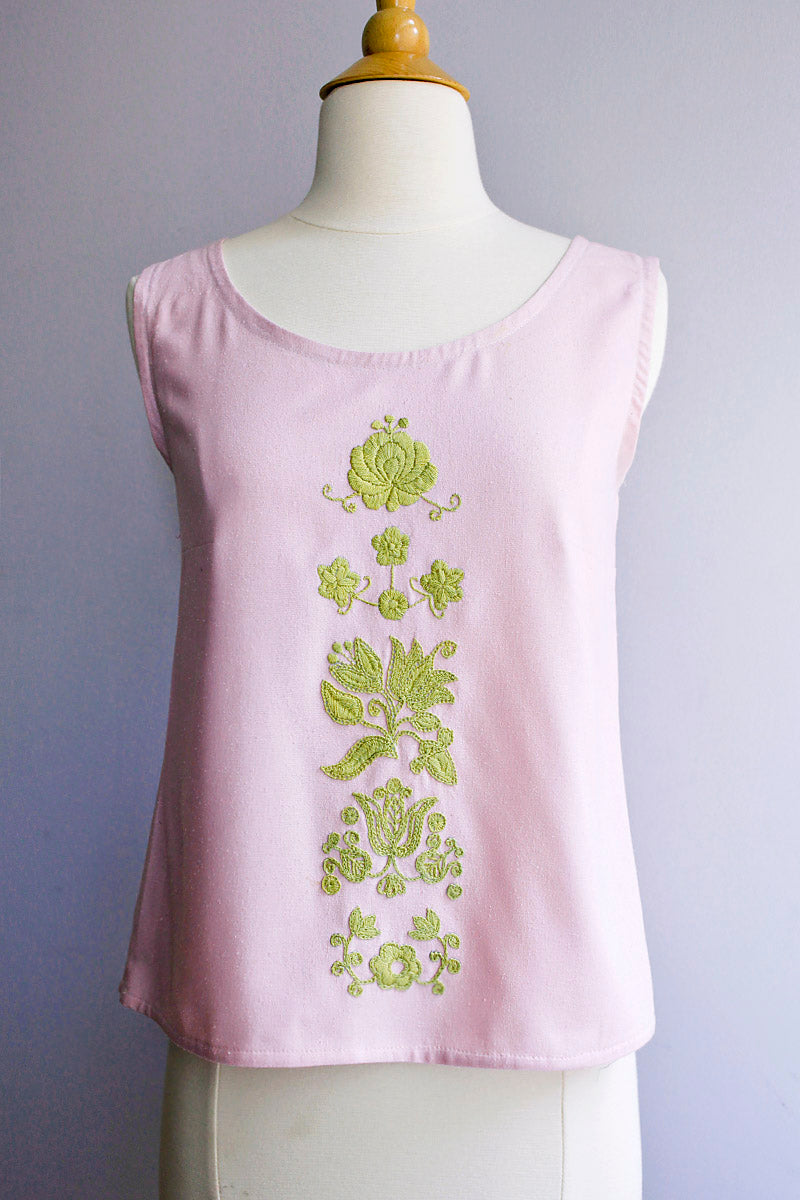
Links to all tutorial pages in the series:
- Hungarian Embroidery Sampler part one: preparations - about threads, needles, hoops, and how to transfer embroidery patterns
- Hungarian Sampler part two: floral motif from Southwestern Hungary - chain stitch, starting and finishing your thread
- Hungarian Sampler part three: Transsylvanian tulips - buttonhole circles, stem stitch
- Hungarian Sampler: administrative update & some additional resources
- Hungarian Sampler part four: witchy stitching from Buzsák - open chain stitch
- Hungarian Sampler part five: filling in the witchy stitching from Buzsák - herringbone filling stitch
- Hungarian Sampler part six: stamina – completing our Buzsák witchy stitching - back stitch, straight satin stitch
- Hungarian Sampler part seven: variations
- Hungarian Sampler part eight: “woolly” stitching from Hungary’s central plains - 'fake' satin stitch
- Hungarian Sampler part nine (the last): Matyó rose from Northern Hungary - oblique or slanted satin stitch
- Blouses to embroider: any blouse with a flat front would work. The Róza top pattern would also work great for this project.
- Download the Hungarian Sampler PDF embroidery pattern (2 pages, formatted to print on either US Letter or A4 size paper).
- Share your work on Instagram and make sure you tag your pics with #kateandrosepatterns #hungariansampler!
